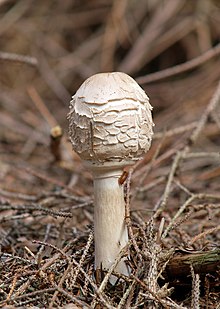Shaggy parasol
| Shaggy parasol | |
|---|---|
 |
|
| Scientific classification | |
| Kingdom: | Fungi |
| Phylum: | Basidiomycota |
| Class: | Agaricomycetes |
| Order: | Agaricales |
| Family: | Agaricaceae |
| Genus: | Chlorophyllum |
| Species complex: | Chlorophyllum rhacodes complex |
| Chlorophyllum rhacodes | |
|---|---|
| Mycological characteristics | |
| gills on hymenium | |
|
|
cap is umbonate or convex |
| hymenium is free | |
| stipe has a ring | |
| spore print is white | |
| ecology is saprotrophic | |
|
|
edibility: choice but not recommended |
cap is umbonate
edibility: choice
The Shaggy parasol is the common name for three closely related species of mushroom, Chlorophyllum rhacodes (or rachodes), C. olivieri and C. brunneum, found in North America, Europe and Southern Africa (the latter species is also found in Australia).
Chlorophyllum rhacodes, C. olivieri and C. brunneum were formerly known as Macrolepiota rhacodes or Lepiota rhacodes, but the name was changed on the basis of molecular phylogenetic evidence demonstrating a closer relationship to Chlorophyllum molybdites than to Macrolepiota procera. The subspecies Macrolepiota rhacodes var. brunneum was also elevated to species status as Chlorophyllum brunneum. Chlorophyllum olivieri is a closely related species that is also eaten as the "Shaggy Parasol."
Many reference works spell the epithet "rachodes" rather than "rhacodes". The spelling "rachodes" was used by Vittadini when he first published the species in 1835, but was erroneous as the Greek word rhakos 'piece of cloth' should be transcribed as rhacos. However Index Fungorum keeps to the original author's spelling "rachodes" and so that is the form which should be regarded as correct.
The shaggy parasol is a large and conspicuous agaric, with thick brown scales and protuberances on its fleshy white cap. The gills and spore print are both white in colour. Its stipe is slender, but bulbous at the base, is coloured uniformly and bears no patterns. It is fleshy, and a reddish, or maroon discoloration occurs and a pungent odour is evolved when it is cut. The egg-shaped caps become wider and flatter as they mature.
...
Wikipedia
